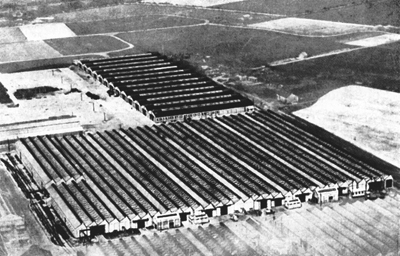|
A
Citroën company, the Citroën Gear Company was set up in England before
the First World War and marketed heavy industrial gearing. In 1919, the
Citroën factory in France exported 750 cars to Britain where they were
sold in the London area by the Citroën concessionaire, Gaston Limited.
By the end of 1921, the company had sold a total of 2 451 vehicles. By
1923, there were over 23 000 Citroëns on British roads. Gastons found
this level of business difficult to service so in 1923, Citroën Cars
Limited was set up in London with its headquarters in the Citroën
Building, Brook Green, Hammersmith to take over the import and
distribution of Citroën vehicles throughout the country.
The
rising demand for the vehicles and the imposition of the McKenna Duties
on imported vehicles led André Citroën to set up an assembly plant to
manufacture cars for the British domestic and Empire (later
Commonwealth) markets where right hand drive cars were the norm. The
Citroën factory, in the Slough Trading Estate was opened on 18th
February 1926 and was to continue building cars until 1965 when the
operation became dedicated to sales and marketing.
Not
only were the cars built with right hand drive steering, they were
frequently renamed and equipped with extras not fitted to the domestic
market vehicles.
One
of the rarest of all production Citroëns was the Slough-built, 2
CV-based Bijou.
|
|
THE AUTOCAR, February 19th, 1926
HOME-PRODUCED FOREIGN CARS.
McKenna Duties Lead to Plans for Manufacturing
Continental Products in this Country on a Large Scale.
AFTER the reimposition of the McKenna
Duties,
it was evident that the manufacturers of the most popular Continental
products would arrange to assemble cars in special works in this
country. The advantage of this practice to this country in general is
obvious, owing to the large number of British hands who would find
employment.
|
 |
|
The
Citroën venture at Slough, for example, is a very good instance in the
case. There are at the present moment two shops, one of 300,000 square.
feet floor space, the other of 200,000 square feet, the former,
therefore, being one of the largest shops in the British Isles. There
are 60 acres of ground, which can be used for further development. The
very latest pattern of moving platform or chain conveyor has been
erected in the shops and is used for assembling the various types of
Citroën, the parts, of course, being supplied from the Citroën factory
in Paris. The whole of the bodywork is also assembled at this shop,and
steps are being taken to manufacture the all~steel saloon which was
exhibited at the last Olympia Show, where it created considerable
interest.
Special Plant for Quick Assembly.
There are special ovens for the painting system, and compressed air
plant of a design later even than that used for the principal factories
in America has been installed to run the drills and mechanical spanners
used in the assembly shop. The components, of course, are erected
separately and fitted to the chassis as it proceeds slowly on the
conveyor, the bare frame being put on, as it were, at one end, the
finished car running off the conveyor at the other. There is a new and
very elaborate system for nickel-plating various parts of the car, and
it is interesting to note that a plant has been installed for dealing
with the plate glass used for windscreens and windows. Into the works
runs a siding from the main Great Western line, so that material can be
received, and chassis sent away, without interruption.
The
works are not yet running at full capacity, but when complete will find
employment for about 5,000 operatives. At the present moment the latest
type of 11.4 h.p. Citroën chassis is being erected, this ,having
appeared at the Brussels Show; and, of course, in France. The principal
difference between the latest model and its predecessors is the
provision of front wheel brakes operating in conjunction‘,with the
brakes on the rear axle, and of special design, with the cam actuating
shaft and cam at the lowest point of the brake drum. Dumb-irons and
half-elliptic springs have replaced the abbreviated frame
quarter-elliptics hitherto used.
Another Continental
firm producing well-known and popular cars for the British market is
getting ready to develop an assembly plant of considerable size, while
the Michelin Tyre Company, as has already been announced in our
columns, are preparing to organise a large factory at Stoke-on-Trent
for the purpose of manufacturing tyres for the British market.
|